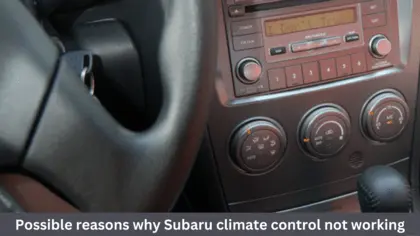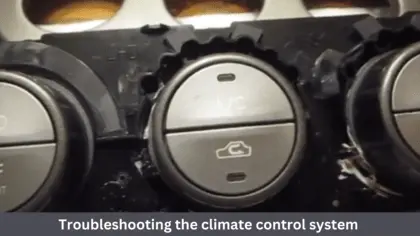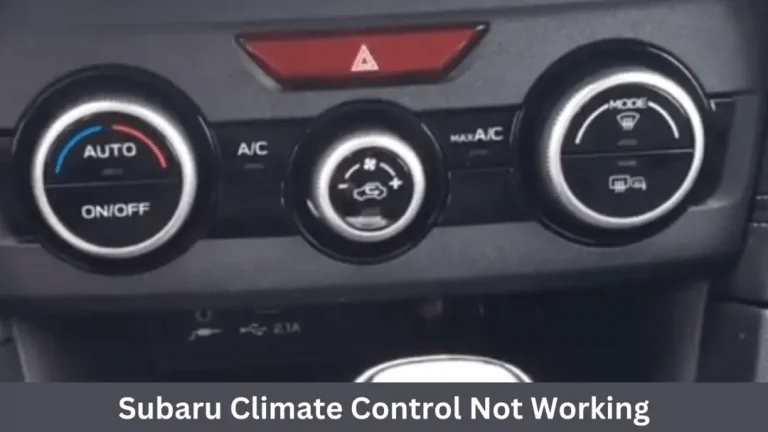Once it was a novelty to have automatic climate control in your car. It was a feature reserved for only the most luxurious and expensive vehicles. However, with the advancement in automotive technology, the climate control feature is now incorporated in more mass-market models and is a more common feature. Subaru cars are one of those vehicles that have a number of models where climate control is integrated. While this feature can control the climate of your car to keep you comfortable, sometimes you may find your Subaru climate control not working.
This issue could occur because of any of the components that are vaguely related to the actual cooling and heating system of the car. These systems are quite complex, which means there are a number of potential failure points. Don’t worry. These three possible causes will help you get an idea of why your Subaru climate control not working.
Possible reasons why Subaru climate control not working

Faulty control module
According to the make and model of the car, the name of this component could vary. However, you know which component is being mentioned here. The control module of climate control is a physical unit that you can find inside the cabin.
This component has screens, dials, and buttons that allow you to regulate the temperature of the cabin. It mostly also contains the electronic hardware needed for controlling the cooling and heating equipment.
You could experience a number of different symptoms if your control module is faulty. Since you are constantly poling and pressing the controls, it is not uncommon to have mechanical issues.
These can even turn into loose dials, damaged screens, broken buttons, or any other defects. Regrettably, oftentimes the only solution is to replace the entire module.
Failed sensors
If the control module is working fine, then the culprit may be a failed sensor. Two sensors are required for a climate control system: a sensor for interior cabin temperature and a sensor for ambient temperature that is located outside of the vehicle.
See more: Subaru Forester interior
These two sensors work together to determine the temperature and strength of the air that is arriving from the vent. The higher-end cars may come with more sophisticated systems that have additional sensors.
In order to provide more even cooling and heating, most modern cars contain more than one temperature sensor in the cabin. Depending on the model, your car may even come with a sensor that will compensate for the temperature of the sunlight that is coming through the windows.
Since there are so many sensors, faulty readings from a single or several of them can significantly affect the cooling and heating system’s efficiency. Often, a faulty code will be triggered in the computer of the car because of bad sensors.
Faulty blend motors
The control modules and sensors are not the only complex thing in a car’s automatic climate control system. Specialized motors are used by most systems to control the proper temperature of the air that comes into the cabin.
In order to maintain the desired temperature, these electric motors enable the climate control system to balance the volume of cold or warm air coming into the cabin.
If the blend motor is broken, it may fail to report its situation to the control module or may entirely halt functioning. And since to control air temperature correctly, the control system needs to know the position of the motor, either of the previously mentioned error can lead to abnormal performance.
Even if a failing motor isn’t impacting the operation of the system yet, it may generate noticeable noises.
Troubleshooting the climate control system

Typically, it is beyond the abilities of a DIY to troubleshoot an automatic climate control system because it requires specialized tools as well as training most of the time.
If an A/C cooling issue is not happening because of a faulty refrigeration circuit, then the culprit could be the automatic temperature control system. Finding the reason requires a scan tool that is able to access as well as read HVAC codes. It is something a simple engine-only scan tool won’t be able to do. Plus, you also need a digital voltmeter, which will help you test the sensors and the circuits.
Most new climate control systems can do self-diagnostic, and generate faulty codes to specify the nature of the issue. However, before a technician replaces any parts, most of the time, he still needs to examine multiple components by measuring resistance, and voltages, looking for shorts or opens in the wiring, and more.
It is very important to run an accurate diagnosis on these systems because various replacement parts are quite costly. Parts such as control modules can cost up to thousands of dollars to change, depending on the car’s application.
If you need to replace other parts such as relays, switches, electric motors, resistors, sensors, vacuum motors, blower motors, and vacuum valves, then you don’t have to worry much about money. However, the labor for installing some of these parts can take hours.
It can be very time-consuming and tough to tear apart the dash as well as the HVAC system. So, if you are not very skilled at it, you must hire a professional to do it for you.
Final Thoughts
The reasons for Subaru climate control not working could be any of the abovementioned ones. Even something else could be causing the issue. So, unless your climate control system’s issue is caused by a simple blown fuse, it is very unlikely you will be able to fix it yourself. The complexity of vehicle HVAC systems is increasing more and more. That is why you must leave this to a professional mechanic to ensure proper diagnosis.


